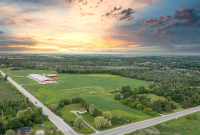If the climate was stable, it would cost about $800 billion to keep Ontario’s public buildings and facilities in a state of good repair until the end of this century, or around $10 billion a year.
Since it isn't, Ontario is looking at an extra cost of $6 billion between now and 2030 — on top of the $10 billion already required annually, the province’s financial watchdog said Tuesday. If Ontario fails to adapt to a warming planet and global emissions keep rising indefinitely, it could tack on an additional $116 billion or more by 2100, making the yearly price tag around $11.5 billion.
The Financial Accountability Office of Ontario (FAO) report says taking action to prepare roughly $250 billion worth of schools, hospitals, water facilities and other provincially and municipally owned assets for climate resiliency would cost a lot of money, but it would be cheaper over time than doing nothing.
“Everything that government does to some degree is a demographic question, a generational question,” said the FAO’s head, Peter Weltman, noting that discussion was beyond the remit of his office’s report but should be a part of the public debate on climate action.
How and when the province chooses to invest in climate resiliency will have a big impact on who foots the bill. Doing nothing now costs nothing but means increasingly frequent one-off events and more rapid deterioration will cost more later, while spending now pays off over time and includes benefits the FAO did not calculate such as the avoidance of secondary impacts due to public service disruption.
The report looked at two possible approaches to adaptation, with a more conservative pathway in which only 77 per cent of buildings are renovated to adapt to climate change by 2100 and a more aggressive investment in retrofitting that would mean most buildings are ready for late-century extremes by 2060.
Weltman said the difference in cost between the reactive and proactive approaches wasn’t very large, but that “the big difference is that what you’re buying is adaptive infrastructure.”
The proactive strategy would cost an extra $54 billion (in 2020 dollars) by 2100 in a scenario where greenhouse gas emissions peak in the 2040 before declining and $104 billion in a scenario in which emissions keep rising throughout the century, while the reactive one would cost either $52 billion or $91 billion, depending on future emissions.
Doing nothing would cost either $66 billion or $116 billion.
The report did not consider other climate hazards, including drought, ice and wind storms, flooded rivers, wildfires, a rise in sea levels or melting permafrost.
“We don’t have enough good data to be able to predict where these crazy events are going to happen going forward,” Weltman said.
The FAO report on the cost of adapting public buildings to deal with climate change is the first of three, with others looking at transportation and water infrastructure still to come.
Morgan Sharp / Local Journalism Initiative / Canada’s National Observer






Comments